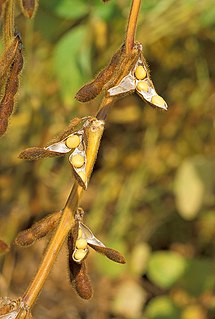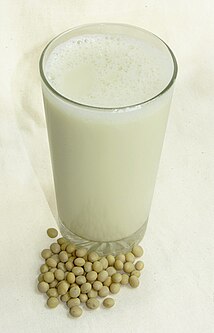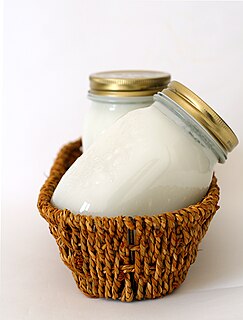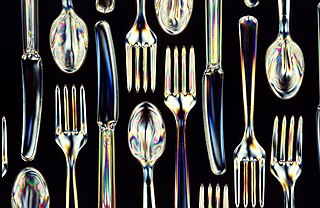
Soy paint is paint made primarily from soy, it combines the advantage of being a renewable resource with the potential of non-toxic product.

Soy paint is paint made primarily from soy, it combines the advantage of being a renewable resource with the potential of non-toxic product.
Soy oils have been used in paint since at least the early 1900s, with paint being the second largest market for the oil in the United States between 1914 and 1918. [1] Soy oil was an early runner to replace linseed oil in paint products but did not transition fully, in part as it was attractive as a food product. [2] In 1933 Robert Boyer developed an enamel soy paint which was used on Ford automobiles. [1] [3] Soy oil was attractive to manufacturers because of its very good drying quantities. [4]
Soy flour or protein is used in latex type (water based) paints as a replacement for casein. [5] Some manufacturers have shown a renewed interest in Soy paints for its low VOC and general Green building attributes. [6] At least one manufacture in 2009 was selling a non-toxic 0 VOC soy paint product. [7]

Acrylic paint is a fast-drying paint made of pigment suspended in acrylic polymer emulsion and plasticizers, silicon oils, defoamers, stabilizers, or metal soaps. Most acrylic paints are water-based, but become water-resistant when dry. Depending on how much the paint is diluted with water, or modified with acrylic gels, mediums, or pastes, the finished acrylic painting can resemble a watercolor, a gouache, or an oil painting, or have its own unique characteristics not attainable with other media.

Paint is any pigmented liquid, liquefiable, or solid mastic composition that, after application to a substrate in a thin layer, converts to a solid film. It is most commonly used to protect, color, or provide texture to objects. Paint can be made or purchased in many colors—and in many different types, such as watercolor or synthetic. Paint is typically stored, sold, and applied as a liquid, but most types dry into a solid. Most paints are either oil-based or water-based and each have distinct characteristics. For one, it is illegal in most municipalities to discard oil-based paint down household drains or sewers. Clean up solvents are also different for water-based paint than they are for oil-based paint. Water-based paints and oil-based paints will cure differently based on the outside ambient temperature of the object being painted Usually the object being painted must be over 10 °C (50 °F), although some manufacturers of external paints/primers claim they can be applied when temperatures are as low as 2 °C (35 °F).

The soybean, soy bean, or soya bean is a species of legume native to East Asia, widely grown for its edible bean, which has numerous uses.

Vegetable oils, or vegetable fats, are oils extracted from seeds or from other parts of fruits. Like animal fats, vegetable fats are mixtures of triglycerides. Soybean oil, grape seed oil, and cocoa butter are examples of fats from seeds. Olive oil, palm oil, and rice bran oil are examples of fats from other parts of fruits. In common usage, vegetable oil may refer exclusively to vegetable fats which are liquid at room temperature. Vegetable oils are usually edible; non-edible oils derived mainly from petroleum are termed mineral oils. Vegetable oil sold in the U.S. is normally synonymous with soybean oil.

Soy milk also known as soya milk or soymilk, is a plant-based drink produced by soaking and grinding soybeans, boiling the mixture, and filtering out remaining particulates. It is a stable emulsion of oil, water, and protein. Its original form is an intermediate product of the manufacture of tofu. Originating in China, it became a common beverage in Europe and North America in the latter half of the 20th century, especially as production techniques were developed to give it a taste and consistency more closely resembling that of dairy milk. Soy milk may be used as a substitute for dairy milk by individuals who are vegan or are lactose intolerant.

Lecithin is a generic term to designate any group of yellow-brownish fatty substances occurring in animal and plant tissues which are amphiphilic – they attract both water and fatty substances, and are used for smoothing food textures, emulsifying, homogenizing liquid mixtures, and repelling sticking materials.

Shortening is any fat that is a solid at room temperature and used to make crumbly pastry and other food products. Although butter is solid at room temperature and is frequently used in making pastry, the term shortening seldom refers to butter, but is more closely related to margarine.

White spirit or mineral spirits, also known as mineral turpentine (AU/NZ), turpentine substitute, and petroleum spirits, is a petroleum-derived clear liquid used as a common organic solvent in painting. There are also terms for specific kinds of mineral spirits, including Stoddard solvent and solvent naphtha (petroleum). Mineral spirits are often used as a paint thinner, or as a component thereof, though paint thinner is a broader category of solvent. Odorless mineral spirits (OMS) have been refined to remove the more toxic aromatic compounds, and are recommended for applications such as oil painting.
Volatile organic compounds (VOC) are organic chemicals that have a high vapour pressure at room temperature. High vapor pressure correlates with a low boiling point, which relates to the number of the sample's molecules in the surrounding air, a trait known as volatility.
Soy ink is a kind of ink made from soybeans. As opposed to traditional petroleum-based ink, soy-based ink is presumed to be more environmentally friendly, might provide more accurate colors, and makes it easier to recycle paper. It is slower to dry than many inks.

Lead paint or lead-based paint is paint containing lead. As pigment, lead(II) chromate (PbCrO4, "chrome yellow"), Lead(II,IV) oxide, (Pb3O4, "red lead"), and lead(II) carbonate (PbCO3, "white lead") are the most common forms. Lead is added to paint to accelerate drying, increase durability, maintain a fresh appearance, and resist moisture that causes corrosion. It is one of the main health and environmental hazards associated with paint. Alternatives such as water-based, lead-free traffic paint are readily available, and many states and federal agencies have changed their purchasing contracts to buy these instead.

Bioplastics are plastic materials produced from renewable biomass sources, such as vegetable fats and oils, corn starch, straw, woodchips, sawdust, recycled food waste, etc. Some bioplastics are obtained by processing directly from natural biopolymers including polysaccharides and proteins, while others are chemically synthesised from sugar derivatives and lipids from either plants or animals, or biologically generated by fermentation of sugars or lipids. In contrast, common plastics, such as fossil-fuel plastics are derived from petroleum or natural gas.

Okara, soy pulp, or tofu dregs is a pulp consisting of insoluble parts of the soybean that remain after pureed soybeans are filtered in the production of soy milk and tofu. It is generally white or yellowish in color. It is part of the traditional cuisines of Japan, Korea, and China. Since the 20th century, it has been used in the vegetarian cuisines of Western nations.

Soy protein is a protein that is isolated from soybean. It is made from soybean meal that has been dehulled and defatted. Dehulled and defatted soybeans are processed into three kinds of high protein commercial products: soy flour, concentrates, and isolates. Soy protein isolate has been used since 1959 in foods for its functional properties.
In China, the adulteration and contamination of several food and feed ingredients with inexpensive melamine and other compounds, such as cyanuric acid, ammeline and ammelide, are common practice. These adulterants can be used to inflate the apparent protein content of products, so that inexpensive ingredients can pass for more expensive, concentrated proteins. Melamine by itself has not been thought to be very toxic to animals or humans except possibly in very high concentrations, but the combination of melamine and cyanuric acid has been implicated in kidney failure. Reports that cyanuric acid may be an independently and potentially widely used adulterant in China have heightened concerns for both animal and human health.

The environmental effects of paint can vary depending on the type of paint used and mitigation measures. Traditional painting materials and processes can have harmful effects on the environment, including those from the use of lead and other additives. Measures can be taken to reduce its environmental effects, including accurately estimating paint quantities so waste is minimized, and use of environmentally preferred paints, coating, painting accessories, and techniques.
Bioproducts or bio-based products are materials, chemicals and energy derived from renewable biological resources.

Milk paint is a nontoxic milk-based paint. It can be made from milk and lime, generally with pigments added for color. In other recipes, borax is mixed with milk's casein protein in order to activate the casein and as a preservative.
Robert Allen Boyer was a chemist employed by Henry Ford, he was extremely proficient at inventing ways to convert soybeans into paints and plastic parts used on Ford automobiles. Robert Allen Boyer, your average “B” chemistry student was given an extraordinary opportunity that changed his future and the future of automobile production in the U.S. (Plastic) Boyer, born on 30 September 1909 in Toledo, Ohio was given this chance when Ford hired his father to run the nation's oldest hotel, the Wayside Inn, in South Sudbury, Massachusetts. Ford frequented the inn and that is where Boyer was discovered. Ford claimed that Boyer had a “keen active mind”. He asked Boyer to enroll in the new Henry Ford Trade School and participate in its unique work-study program instead of following his plans to enter Andover prep school and then Dartmouth College (Shurtleff). Boyer excelled in the Ford Trade School and took to exploring concepts such as how to manufacture synthetic wool from soybeans. These were the types of problems that stumped the experts (Plastic). Boyer graduated the Ford Trade School at the age of 21 with a promising chemistry career in front of him. He started this career as the head of the soybean lab at the Edison Institute (Shurtleff). Here Boyer’s career took off. He started working to use soybeans in ways they had never been used before. Boyer has done things from extracting lubricating and paint oils from the soybean to creating a synthetic wool made from soybeans and pressing insulating varnish for starters and generators (Plastic). One of Boyer’s first projects began in 1932 and included building “a small solvent extractor to separate the bean into soy oil and protein-rich meal” (Shurtleff). The soybean oil became the most crucial commercial soy products on Ford cars. In 1934 the five to eight coats of lacquer that cars previously had been finished with was replaced with a synthetic baked enamel paint which contained about 35% soy oil. This new synthetic paint with soy oil saved considerable time and money. In 1937, Boyer developed a curved plastic sheet which he hoped would replace steel in the auto bodies of ford cars. He was so confident in his product that he took an axe to it in the middle of a crowd of reporters and critics. He also jumped up and down on the curved sheet. When there was no bending in the sheet and no shattering due to the axe and the weight of him jumping on the sheet, people were astounded (shurtleff). This soy protein plastic sheet consist of 70% cellulose and 30% resin binder pressed into cloth. “The new rust-free, dent-proof plastic was reportedly 50% lighter and 50% cheaper to produce than steel” (Shurtleff). This new plastic body cut the total weight of the car from 3,000 lb. to 2,000 (Dearborn). The sheets look like polished steel and can be bent but just snap back into place, therefore when caught in fender benders, the fender would bounce back like “rubber balls” (Shurtleff). Needless to say, this product was a breakthrough in the world of automobile production. Boyer also used the soy isolates to produce the world's first plant protein fiber in 1938. (Shurtleff.) This fiber resembled a soft wool, it was tan in color, had a medium luster and a soft warm feel. “it has 80% the strength of wool, took the same dyes, had good elongation, and did not wet as easily as wool.”(Shurtleff). Boyer figured this fiber could be used for upholstery in cars, filling in felt hats, or for clothing. Boyer changed the way the soybean was used and created innovative products we use daily.
|accessdate= (help)